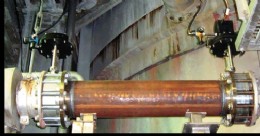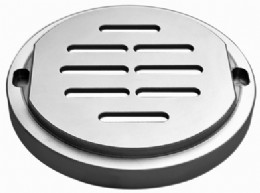Steam systems efficiency optimised by control elements
Eichbaum Brewery replaces boiler room seat valves with Schubert & Salzer sliding gate valves



Even less wear with a short stroke
In the sliding gate valve principle, with surface seal between the plates in the throttling element, the pressure of the medium against the movable valve plate boosts the sealing function of the valve. This operating principle also provides for a self-lapping action by the movable valve plate. The result of this is that the surface sealing system is significantly less susceptible than a conventional ring seal in a globe-type valve. As a result, leakage rates of less than 0.0001 % of the Kvs value are achieved.
In addition to a highly effective permanent seal, the sliding gate valve offers a further benefit inherent in its system which affects its effective working life. The control stroke of the sliding gate valve is a mere 8 mm at most. This short stroke results not only in short operating paths and times, but also significantly reduces the stresses on both the packing as well as on any actuator operating it. In a sliding gate valve, both are subject to much lower loads which is reflected in substantially longer working lives for both.
No problems at all in exchanges
A sliding gate valve is extremely narrow in construction and fits easily between two flanges. A DN 150 sliding gate valve (including actuator) weighs a mere 14.2 kg, so that it can be fitted and removed by a single person, and, therefore, can also be maintained. The compact construction and therefore the significantly smaller amount of space required for the sliding gate valve were key decision criteria for Eichbaum in placing their reliance on these valves for the mash house and the filter cellar. Thus, this ease of handling the sliding gate valve was a decisive and cost-reducing benefit not only for installation but also for maintenance.
When any conventional valve requires maintenance, the complete valve body has to be dismantled to gain access to the seating elements. And, as a rule, this involves two workers. This is not the case with the sliding gate valve. One person only is needed to remove and maintain the throttling element on site in the plant. In the standard version of the sliding gate valve, after removing the valve, a single screw is unscrewed to access the operating unit, which can then be pressed out and exchanged.
In contrast to the traditional globe-type valve, since its throttling elements are designed to be perpendicular to the flow, the sliding gate valve needs barely a tenth of the force for positioning and closing. The comparatively low force requirement not only means significantly lower energy consumption, but also provides for smaller valves and smaller valve actuators - which is therefore clearly evident in volume and weight.
The Eichbaum Brewery is now using type 8021 sliding gate valves in sizes DN 80 to DN 200 in its main steam supply circuit. The DN 200 versions are used, for example, to control the amount of pressure up to 16 bar differential pressure at the boiler, serving as fastacting shut-off valves as a safety measure in power failures, or, in traditional fashion, to control the amount of steam pressure.
Variable Kvs values for a secure future
It is a simple matter in a sliding gate valve to manipulate both the characteristic curve of the valve as well as the flow factors (Kvs value) in almost any manner. As a result, the sliding gate valve can be adapted easily to widely differing flow volumes.
All that is needed is an appropriate form of the slit profile in the sliding plates adapted to almost any conceivable shape. In this way, it is possible, for instance, to produce equal-percentage characteristics (exponential).The basic characteristic curve where the slits in the valve plates are straight (long holes) shows that the valve characteristics are similar to the valve characteristics of rotary plug valves, which can be designated as “modified linear.”
Kvs value reductions within a nominal size are also simple to achieve by reducing the open slit areas. As a consequence, just by exchanging the operating element, the Kvs value can be modified at any time retroactively (Kvs values from 0.04 to 910 can be attained in all nominal sizes). This means that the Eichbaum Brewery can react flexibly and without incurring high investment costs to changes in the quantities of steam required.
Sliding gate valves are produced in sizes DN 15 to DN 250 for pressures up to PN 100 and median temperatures from - 200°C to + 530°C. The wide range of materials and different positioners offer applications in the chemical, textile and pharmaceutical industries, steel works and many other sectors.
The compact construction and therefore the significantly smaller amount of space required for the sliding gate valve were key decision criteria for Eichbaum in placing their reliance on these valves for the mash house and the filter cellar.
The perforated plates sliding against each other form the main throttling element in sliding gate valves. Since metal seats can be dispensed with in this system, scoring is eliminated which, in conventional valves, results very rapidly in expensive leaking.
Schubert & Salzer
Tel: 01952 462021
www.saint-gobain-pam.co.uk
Published: 3rd December 2012
Rachel Wormald, Managing Director at YPS Valves Ltd and Elizabeth Waterman, ...
Are you looking for industry-leading, brand independent valve and actuator ...
As can be seen from the photograph, clearly the resident birds at Bartlett ...
Howco Group has unveiled its latest £1million investment, with the ...
In 2024, Allvalves is poised for an exciting year of growth and expansion, ...
GMM Pfaudler Engineered Plastics & Gaskets are delighted to bring the ...
In the ever-evolving valve industry, GMM Pfaudler stands out for its ...
SAMSON Controls Ltd – part of the SAMSON group - a renowned leader in ...










